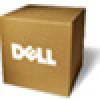Dell PowerConnect Brocade M6505 Hardware Reference Manual - Page 24
System reliability guidelines, Handling static-sensitive devices, Preparing the Blade Server
 |
View all Dell PowerConnect Brocade M6505 manuals
Add to My Manuals
Save this manual to your list of manuals |
Page 24 highlights
2 System reliability guidelines System reliability guidelines To help ensure proper cooling, performance, and system reliability, make sure the following requirements are met: • Each of the I/O module bays at the rear of the Dell M1000e Blade Server Enclosure contains either a SAN I/O Module or a filler panel. • A removed hot-swappable SAN I/O Module is replaced with an identical SAN I/O Module or filler panel within 60 seconds of removal. • You have followed the reliability guidelines in the documentation that comes with the Dell M1000e Blade Server Enclosure. Handling static-sensitive devices ATTENTION Static electricity can damage the Dell M1000e Blade Server Enclosure and other electronic devices. To avoid damage, keep static-sensitive devices in their static-protective packages until you are ready to install them. To reduce the possibility of electrostatic discharge, observe the following precautions: • Limit your movement. Movement can cause static electricity to build up around you. • Handle the device carefully, holding it by its edges or its frame. • Do not touch solder joints, pins, or exposed printed circuitry. • Do not leave the device where others can handle and damage it. • While the device is still in its static-protective package, touch it to an unpainted metal surface of the Dell M1000e Blade Server Enclosure or an unpainted metal surface on any other grounded rack component in the rack in which you are installing the device for at least two seconds. This drains static electricity from the package and from your body. • Remove the device from its package and install it directly into the Dell M1000e Blade Server Enclosure without setting down the device. If it is necessary to set down the device, put it back into its static-protective package. Do not place the device on the Dell M1000e Blade Server Enclosure or on a metal surface. • Take additional care when you handle devices during cold weather. Heating reduces indoor humidity and increases static electricity. • Some types of chassis come with electrostatic discharge (ESD) connectors. If the chassis is equipped with an ESD connector, see the documentation that comes with the Dell M1000e Blade Server Enclosure for using the ESD connector. Preparing the Blade Server Enclosure for the SAN I/O Module Before the SAN I/O Module can be inserted in the Dell M1000e Blade Server Enclosure, make sure the following conditions are met: • The I/O module bay into which the SAN I/O Module will be inserted is ready to receive the SAN I/O Module. • All power requirements specific to the Dell M1000e Blade Server Enclosure are met. 12 Brocade M6505 16 Gbps Fibre Channel SAN I/O Module Hardware Reference Manual 53-1002576-02















